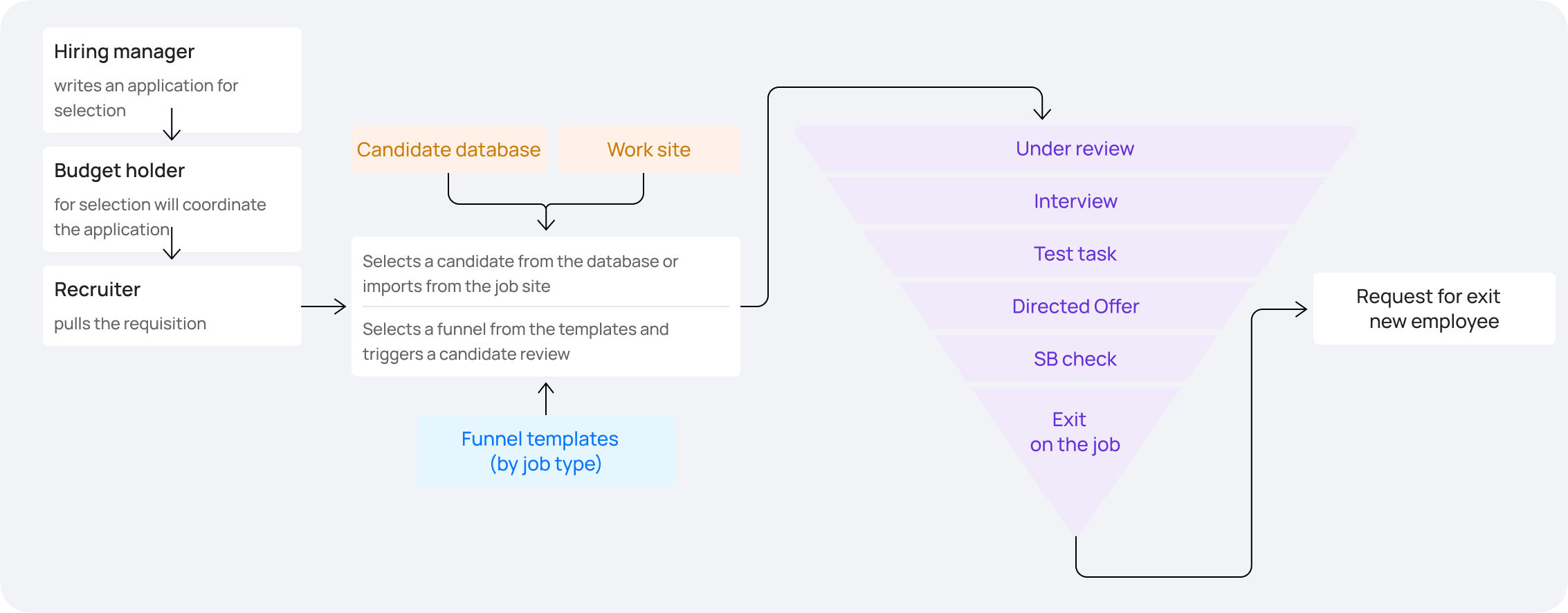Finding an employee is a long and expensive task for businesses. A good candidate can be off the market in as little as three days, which is why companies struggle with speed and quality of hire. To catch the best talent on the labor market faster, it pays to automate recruiting processes with the help of technologies that take over much of the manual work of HR specialists.
We tell you why automated recruiting is good for business and how to choose a solution for automating processes.
What is recruiting and why automate it
Recruitment is the process of finding, selecting and hiring employees for a company. It covers all the way from analyzing the needs of the organization to putting an offer to the selected candidate. In the course of recruiting, HR specialists create a job description, search for applicants through various channels, screen resumes and conduct interviews, evaluate applicants and make a hiring decision.
Despite the importance of this process for companies, especially when scaling, modern recruiting faces some serious challenges. The cost of hiring is constantly rising due to the shortage of staff on the labor market – if it used to take 2-3 weeks to find, for example, a developer, now this process can drag on for months. At the same time, routine operations take up to 80% of a recruiter’s time: posting vacancies, initial selection of resumes, scheduling interviews. A specialist cannot focus on finding good staff because of the large volume of routine operations, which makes the time and cost of recruitment swell even more.
Also, hiring managers often don’t understand what is happening in the candidate selection process – they can’t see how many resumes have been reviewed, what stage candidates are at, and why the process is dragging on.
To solve these problems, businesses are turning to automatization of recruiting processes, and with the proper implementation of technology, the work of the HR department becomes more productive:
- the system takes care of all tasks that do not require complex communication, for example, automatically publishes vacancies on job sites, collects responses, sorts resumes by specified criteria;
- HR-specialist is involved only where human interaction is needed – conducting interviews, evaluating candidates’ soft skills, making the final hiring decision;
- computer makes formal decisions, while a human makes strategic decisions; so the system can automatically screen out candidates who do not meet the basic requirements, while the recruiter decides who to invite for an interview.
- HR specialist is involved only where human interaction is needed – conducting interviews, assessing candidates’ soft skills, making the final decision
“This is how, for example, an automated candidate selection process might look like: a bot searches for suitable resumes according to specified criteria and places them in the company’s database, then the AI evaluates them by relevance and ranks them from the most suitable to the least – the recruiter only has to take the first dozen resumes from the database and schedule interviews for the candidates. This approach allows us to focus on qualitative assessment of candidates and making informed hiring decisions”,
— Maria Pizhurina, SimpleOne HRMS product owner
Benefits of automating recruitment
Moving towards hiring automation helps a company hire better quality talent faster and cheaper by saving time. Tools such as ATS (Applicant Tracking System, an applicant management system) class systems, HR platforms to consolidate HR processes, resume screening bots or AI-based technologies minimize the routine of a recruiter’s job.
Automated Recruitment allows:
- save HR-specialists’ time on routine operations – instead of posting vacancies or sorting resumes manually, recruiters can focus on communicating with promising candidates;
- faster time to find and hire top-notch talent – in tight staffing environments, speed of response often determines hiring success, and with the help of technology, recruiters are more responsive in processing responses and scheduling interviews;
- make decisions based on concrete numbers and data – HR managers can justify the need to invest in recruitment, based on statistics on the timing of closing vacancies or the quality of hiring;
- save time of hiring managers for interaction with HR – managers have access to up-to-date information on the progress of recruitment through the HR-system, without contacting the recruiter directly. In the system the hiring manager can see how many candidates have passed each stage of selection, what their strengths are and at what stage of the process is the approval of the offer, which increases the transparency of the HR department and helps to optimize hiring processes.
Operations that require automation
In the hiring process, many tasks take up recruiters’ time but don’t require in-depth expertise. Automating these operations frees up HR professionals’ resources to work with candidates and hiring managers. Here are eight key recruiting steps that lend themselves to automation:
| Recruitment Planning | The system generates hiring plans based on company needs and budget, and automatically calculates the workload for the HR department. |
| Placement and processing of selection requests | Hiring managers fill out structured applications, the system forwards them to recruiters and tracks the status of fulfillment. |
| Formulating and Publishing Jobs | A job description is generated on the basis of the application, the system posts it on selected job sites and corporate portal. |
| Searching and ranking suitable resumes | The bot analyzes resume databases and searches for candidates, and the AI ranks them by relevance – saving up to 70% of a recruiter’s time in the initial screening process. |
| Primary candidate information gathering | Automated questionnaires collect basic information about applicants, and chatbots conduct initial interviews to weed out unsuitable candidates. |
| Release and processing of test scores | The system sends out test cases, monitors their completion and automatically checks the results, reports are available to the recruiter and hiring manager. |
| Offer Generation and Matching | Job offers are created on the basis of templates, the system organizes the process of matching and sending the offer to the candidate. |
| Collecting and processing documents when a new employee leaves | A list of documents required for hiring is generated, the system recognizes them and enters the data into the database. |
How to choose a recruiting automation system?
To automate recruiting in medium and large companies will be suitable for a system class HRMS or specialized CRM for recruiting (ATS) – for example, ATS is included in the solution SimpleOne HRMS.
When choosing a solution it is worth paying attention to the following aspects:
- process coverage – the system should automate the entire cycle from hiring planning to employee onboarding;
- flexibility of customization – the ability to adapt processes to the specifics of the company, for example, with the help of low-code/no-code tools;
- integration with other systems – compatibility with used work sites, corporate portal, personnel accounting system;
- analytical capabilities – availability of built-in reports and dashboards to assess the effectiveness of hiring.
For example, SimpleOne HRMS offers a comprehensive recruiting automation solution that covers all key aspects of the hiring process:
- automating the processing of recruitment applications;
- maintaining a structured candidate database;
- setting up selection funnels for different types of positions;
- creation and coordination of job descriptions;
- integration with popular job sites;
- preparing and coordinating job offers;
- vacancy planning and template management;
- forming analytical reporting on the recruitment funnel in terms of job categories and sources of attracting candidates;
The advantage of such comprehensive systems is that they allow you to automate not only recruitment, but also related HR processes to build a holistic approach to HR management and track an employee’s journey from candidate to termination in a single system.
Resume
Recruiting automation is a necessary step for companies that want to speed up hiring and reduce its cost. Modern HR systems take over routine tasks, allowing recruiters to focus on quality candidate assessment. As a result, businesses find the right talent faster and make data-driven decisions.
When choosing an automation solution, it’s worth paying attention to comprehensive HRMS platforms. They not only optimize the recruitment process, but also allow you to manage the entire employee life cycle: from recruitment planning to dismissal. This approach ensures the integrity of HR processes and helps to build a unified HR management system.


